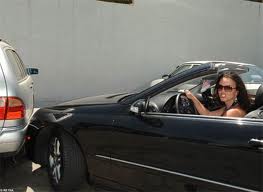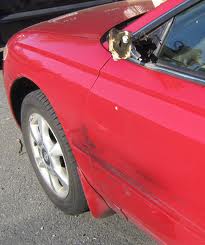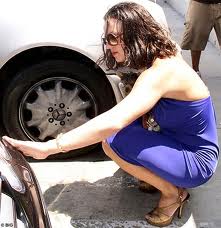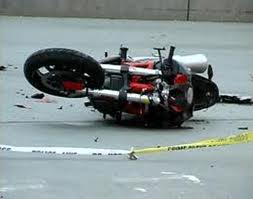Hit & Run
Just as the O. J. Simpson murder trial focused the nation’s attention on domestic violence issues, the 2007 ‘Hit & Run’ prosecution of Brittney Spears in Los Angeles drew attention to the duties of a driver following car accident.
California has two hit and run statutes. Vehicle Code 20001 defines ‘felony’ hit and run as fleeing the scene of an accident in which a third party is injured. Vehicle Code 20002 defines ‘misdemeanor’ hit and run as fleeing the scene of an accident that causes property damage only, no injuries.
The difference between the two laws lies primarily in the penalties. The misdemeanor statute carries only up to six months local jail time. Violating the felony hit and run statute, however, can land someone in California state prison for three years or longer.
The fact is, a person’s responsibilities following an accident are fairly straightforward. The driver must stop immediately and provide the other parties with his name and vehicle registration. If another party is injured, one must provide aid and assistance in addressing the injuries. Failing to do take these measures subjects one being charged under the hit and run laws.
Hit & Run – The Law:
Vehicle Code Section 20002 – ‘Misdemeanor’ Hit & Run (‘Felony’ see below) States:
“20002. (a) The driver of any vehicle involved in an accident resulting only in damage to any property, including vehicles, shall immediately stop the vehicle at the nearest location that will not impede traffic or otherwise jeopardize the safety of other motorists. Moving the vehicle in accordance with this subdivision does not affect the question of fault. The driver shall also immediately do either of the following:
(1) Locate and notify the owner or person in charge of that property of the name and address of the driver and owner of the vehicle involved and, upon locating the driver of any other vehicle involved or the owner or person in charge of any damaged property, upon being requested, present his or her driver’s license, and vehicle registration, to the other driver, property owner, or person in charge of that property. The information presented shall include the current residence address of the driver and of the registered owner. If the registered owner of an involved vehicle is present at the scene, he or she shall also, upon request, present his or her driver’s license information, if available, or other valid identification to the other involved parties.
(2) Leave in a conspicuous place on the vehicle or other property damaged a written notice giving the name and address of the driver and of the owner of the vehicle involved and a statement of the circumstances thereof and shall without unnecessary delay notify the police department of the city wherein the collision occurred or, if the collision occurred in unincorporated territory, the local headquarters of the Department of the California Highway Patrol.
(b) Any person who parks a vehicle which, prior to the vehicle again being driven, becomes a runaway vehicle and is involved in an accident resulting in damage to any property, attended or unattended, shall comply with the requirements of this section relating to notification and reporting and shall, upon conviction thereof, be liable to the penalties of this section for failure to comply with the requirements.
(c) Any person failing to comply with all the requirements of this section is guilty of a misdemeanor and, upon conviction thereof, shall be punished by imprisonment in the county jail not exceeding six months, or by a fine not exceeding one thousand dollars ($1,000), or by both that imprisonment and fine.”
Hit & Run – Misdemeanor: What the Prosecutor MUST Prove Beyond a Reasonable Doubt
Jury Instruction 2150. Failure to Perform Duty Following Accident: Property Damage – Defendant Driver
The defendant is charged [in Count ______] with failing to perform a legal duty following a vehicle accident that caused property damage.
To prove that the defendant is guilty of this crime, the People must prove that:
1. While driving, the defendant was involved in a vehicle accident;
2. The accident caused damage to someone else’s property;
3. The defendant knew that (he/she) had been involved in an accident that caused property damage [or knew from the nature of the accident that it was probable that property had been damaged];
[AND]
4. The defendant willfully failed to perform one or more of the following duties: (a) To stop immediately at the scene of the accident; OR (b) To provide the owner or person in control of the damaged property with (his/her) name and current residence address [and the name and address of the owner of the vehicle the defendant was driving].
The driver of a vehicle may provide the required information in one of two ways:
1. The driver may locate the owner or person in control of the damaged property and give that person the information directly. On request, the driver must also show that person his or her driver’s license and the vehicle registration;
[OR]
2. The driver may leave the required information in a written note in a conspicuous place on the vehicle or other damaged property. The driver must then also, without unnecessary delay, notify either the police department of the city where the accident happened or the local headquarters of the California Highway Patrol if the accident happened in an unincorporated area.
Someone commits an act willfully when he or she does it willingly or on purpose. It is not required that he or she intend to break the law, hurt someone else, or gain any advantage.
The duty to stop immediately means that the driver must stop his or her vehicle as soon as reasonably possible under the circumstances.
The driver of a vehicle must perform the duties listed regardless of how or why the accident happened. It does not matter if someone else caused the accident or if the accident was unavoidable.
You may not find the defendant guilty unless all of you agree that the People have proved that the defendant failed to perform at least one of the required duties. You must all agree on which duty the defendant failed to perform.
[To be involved in a vehicle accident means to be connected with the accident in a natural or logical manner. It is not necessary for the driver’s vehicle to collide with another vehicle or person.]
[When providing his or her name and address, the driver is required to identify himself or herself as the driver of a vehicle involved in the accident.]
[The property damaged may include any vehicle other than the one allegedly driven by the defendant.]
[An accident causes property damage if the property damage is the direct, natural, and probable consequence of the accident and the damage would not have happened without the accident. A natural and probable consequence is one that a reasonable person would know is likely to happen if nothing unusual intervenes. In deciding whether a consequence is natural and probable, consider all the circumstances established by the evidence.]
[There may be more than one cause of property damage. An accident causes property damage only if it is a substantial factor in causing the damage. A substantial factor is more than a trivial or remote factor. However, it need not be the only factor that causes the property damage.]
[If the accident caused the defendant to be unconscious or disabled so that (he/she) was not capable of performing the duties required by law, then (he/she) did not have to perform those duties at that time. [However, (he/she) was required to do so as soon as reasonably possible.]]”

This is a common crime in California, with thousands of prosecutions each year. Usually the case is resolved with the offender serving probation and paying restitution to the other party. However, John J. Stanley & Associates has been successful on numerous occasions in resolving a Hit & Run cases as a ‘Civil Compromise’, a result which leaves the accused with no criminal record.
It should be noted, however, that in more serious cases, the offender may do substantial time in custody.
Vehicle Code Section 20001 – ‘Felony’ Hit & Run
“20001. (a) The driver of a vehicle involved in an accident resulting in injury to a person, other than himself or herself, or in the death of a person shall immediately stop the vehicle at the scene of the accident and shall fulfill the requirements of Sections 20003 and 20004.
(b) (1) Except as provided in paragraph (2), a person who violates subdivision (a) shall be punished by imprisonment in the state prison, or in a county jail for not more than one year, or by a fine of not less than one thousand dollars ($1,000) nor more than ten thousand dollars ($10,000), or by both that imprisonment and fine.
(2) If the accident described in subdivision (a) results in death or permanent, serious injury, a person who violates subdivision (a) shall be punished by imprisonment in the state prison for two, three, or four years, or in a county jail for not less than 90 days nor more than one year, or by a fine of not less than one thousand dollars ($1,000) nor more than ten thousand dollars ($10,000), or by both that imprisonment and fine. However, the court, in the interests of justice and for reasons stated in the record, may reduce or eliminate the minimum imprisonment required by this paragraph.
(3) In imposing the minimum fine required by this subdivision, the court shall take into consideration the defendant’s ability to pay the fine and, in the interests of justice and for reasons stated in the record, may reduce the amount of that minimum fine to less than the amount otherwise required by this subdivision.
(c) A person who flees the scene of the crime after committing a violation of Section 191.5 of, or paragraph (1) of subdivision (c) of Section 192 of the Penal Code, upon conviction of any of those sections, in addition and consecutive to the punishment prescribed, shall be punished by an additional term of imprisonment of five years in the state prison. This additional term shall not be imposed unless the allegation is charged in the accusatory pleading and admitted by the defendant or found to be true by the trier of fact. The court shall not strike a finding that brings a person within the provisions of this subdivision or an allegation made pursuant to this subdivision.
(d) As used in this section, “permanent, serious injury” means the loss or permanent impairment of function of a bodily member or organ.”
Hit & Run – Felony: What the Prosecutor MUST Prove Beyond a Reasonable Doubt
Jury Instruction 2140. Failure to Perform Duty Following Accident: Death or Injury – Defendant Driver
The defendant is charged [in Count ______] with failing to perform a legal duty following a vehicle accident that caused (death/ [or] [permanent] injury) to another person.
To prove that the defendant is guilty of this crime, the People must prove that:
1. While driving, the defendant was involved in a vehicle accident;
2. The accident caused (the death of/ [or] [permanent, serious] injury to) someone else;
3. The defendant knew that (he/she) had been involved in an accident that injured another person [or knew from the nature of the accident that it was probable that another person had been injured];
[AND]
4. The defendant willfully failed to perform one or more of the following duties:
(a) To stop immediately at the scene of the accident;
(b) When requested, to show (his/her) driver’s license, or any other available identification, to (the person struck/the driver or occupants of any vehicle collided with) or any peace officer at the scene of the accident;
(c) To provide reasonable assistance to any person injured in the accident;
[OR]
(d) To give to (the person struck/the driver or occupants of any vehicle collided with) or any peace officer at the scene of the accident all of the following information:
The defendant’s name and current residence address;
[AND]
The registration number of the vehicle (he/she) was driving
<Give following sentence if defendant not owner of vehicle.>
[AND]
The name and current residence address of the owner of the vehicle if the defendant is not the owner]
<Give following sentence if occupants of defendant’s vehicle were injured.>
[AND]
The names and current residence addresses of any occupants of the defendant’s vehicle who were injured in the accident]
<Give element 4(e) if accident caused death.>
[OR]
(e) The driver must, without unnecessary delay, notify either the police department of the city where the accident happened or the local headquarters of the California Highway Patrol if the accident happened in an unincorporated area.]
Someone commits an act willfully when he or she does it willingly or on purpose. It is not required that he or she intend to break the law, hurt someone else, or gain any advantage.
The duty to stop immediately means that the driver must stop his or her vehicle as soon as reasonably possible under the circumstances.
To provide reasonable assistance means the driver must determine what assistance, if any, the injured person needs and make a reasonable effort to see that such assistance is provided, either by the driver or someone else. Reasonable assistance includes transporting anyone who has been injured for medical treatment, or arranging the transportation for such treatment, if it is apparent that treatment is necessary or if an injured person requests transportation. [The driver is not required to provide assistance that is unnecessary or that is already being provided by someone else. However, the requirement that the driver provide assistance is not excused merely because bystanders are on the scene or could provide assistance.]
The driver of a vehicle must perform the duties listed regardless of who was injured and regardless of how or why the accident happened. It does not matter if someone else caused the accident or if the accident was unavoidable.
You may not find the defendant guilty unless all of you agree that the People have proved that the defendant failed to perform at least one of the required duties. You must all agree on which duty the defendant failed to perform.
[To be involved in a vehicle accident means to be connected with the accident in a natural or logical manner. It is not necessary for the driver’s vehicle to collide with another vehicle or person.]
[When providing his or her name and address, the driver is required to identify himself or herself as the driver of a vehicle involved in the accident.]
[A permanent, serious injury is one that permanently impairs the function or causes the loss of any organ or body part.]
[An accident causes (death/ [or] [permanent, serious] injury) if the (death/ [or] injury) is the direct, natural, and probable consequence of the accident and the (death/ [or] injury) would not have happened without the accident. A natural and probable consequence is one that a reasonable person would know is likely to happen if nothing unusual intervenes. In deciding whether a consequence is natural and probable, consider all the circumstances established by the evidence.]
[There may be more than one cause of (death/ [or] [permanent, serious] injury). An accident causes (death/ [or] injury) only if it is a substantial factor in causing the (death/ [or] injury). A substantial factor is more than a trivial or remote factor. However, it need not be the only factor that causes the (death/ [or] injury).]
[If the accident caused the defendant to be unconscious or disabled so that (he/she) was not capable of performing the duties required by law, then (he/she) did not have to perform those duties at that time. [However, (he/she) was required to do so as soon as reasonably possible.]]
Hit and Run
If you or someone you know has been charged with Hit & Run, contact John J. Stanley & Associates at (818) 769-5200 for your free consultation.


